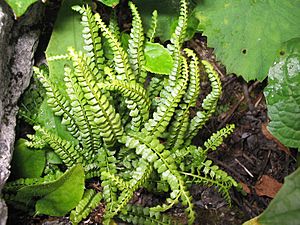Green spleenwort facts for kids
Quick facts for kids Green spleenwort |
|
|---|---|
 |
|
| Conservation status | |
| Scientific classification | |
| Genus: |
Asplenium
|
| Species: |
viride
|
The green spleenwort, known scientifically as Asplenium viride, is a type of fern. It gets its common name because its stems, called stipes, and the main stalk of its leaves, called rachides, are bright green. This green color helps tell it apart from a very similar fern, the maidenhair spleenwort (Asplenium trichomanes), which has darker stems.
How Green Spleenwort Got Its Name
A famous scientist named Carl Linnaeus first described the green spleenwort in 1753. He wrote about it in his book Species Plantarum. He gave it a long name, Asplenium Trichomanes ramosum.
Later, another botanist, William Hudson, gave it the name Asplenium viride. This name stuck! Viride is a Latin word that means "green," which fits the fern perfectly. Hudson found this fern growing on damp rocks in the mountains of Wales, Yorkshire, and Westmorland.
Its Family Tree
Scientists have studied the Asplenium group of ferns to understand how they are related. They found that these ferns can be divided into different "clades," which are like family branches.
The green spleenwort belongs to the "A. viride subclade." This small group is part of a larger family branch called the "A. trichomanes clade." Ferns in this larger group grow on rocks all over the world. They usually have long, thin, dark brown stems.
What makes the A. viride subclade special is that its members have green stems. This group includes only the green spleenwort and its close relative, A. adulterinum.
Where Green Spleenwort Lives
The green spleenwort is a small fern that grows on rocks. It likes rocks that contain calcium carbonate, like limestone. You can find this fern naturally in northern and western North America, and in northern Europe and Asia.
This fern is a "diploid" species, which means it has two sets of chromosomes. It can also create a hybrid fern when it mixes with the maidenhair spleenwort. This new fern is called Asplenium × adulterinum and has been found on Vancouver Island in British Columbia.
See also
 In Spanish: Culantrillo para niños
In Spanish: Culantrillo para niños



